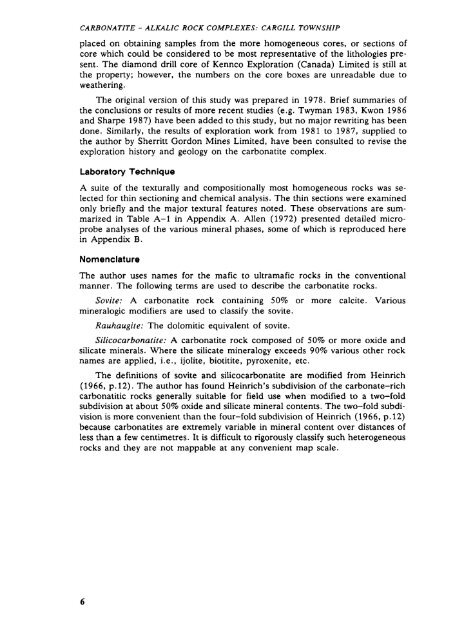Cargill Township carbonatite complex, District of ... - Geology Ontario
Cargill Township carbonatite complex, District of ... - Geology Ontario
Cargill Township carbonatite complex, District of ... - Geology Ontario
You also want an ePaper? Increase the reach of your titles
YUMPU automatically turns print PDFs into web optimized ePapers that Google loves.
CARBONATITE - ALKALIC ROCK COMPLEXES: CARGILL TOWNSHIP<br />
placed on obtaining samples from the more homogeneous cores, or sections <strong>of</strong><br />
core which could be considered to be most representative <strong>of</strong> the lithologies pre<br />
sent. The diamond drill core <strong>of</strong> Kennco Exploration (Canada) Limited is still at<br />
the property; however, the numbers on the core boxes are unreadable due to<br />
weathering.<br />
The original version <strong>of</strong> this study was prepared in 1978. Brief summaries <strong>of</strong><br />
the conclusions or results <strong>of</strong> more recent studies (e.g. Twyman 1983, Kwon 1986<br />
and Sharpe 1987) have been added to this study, but no major rewriting has been<br />
done. Similarly, the results <strong>of</strong> exploration work from 1981 to 1987, supplied to<br />
the author by Sherritt Gordon Mines Limited, have been consulted to revise the<br />
exploration history and geology on the <strong>carbonatite</strong> <strong>complex</strong>.<br />
Laboratory Technique<br />
A suite <strong>of</strong> the texturally and compositionally most homogeneous rocks was se<br />
lected for thin sectioning and chemical analysis. The thin sections were examined<br />
only briefly and the major textural features noted. These observations are sum<br />
marized in Table A-1 in Appendix A. Allen (1972) presented detailed micro<br />
probe analyses <strong>of</strong> the various mineral phases, some <strong>of</strong> which is reproduced here<br />
in Appendix B.<br />
Nomenclature<br />
The author uses names for the mafic to ultramafic rocks in the conventional<br />
manner. The following terms are used to describe the <strong>carbonatite</strong> rocks.<br />
Sovite: A <strong>carbonatite</strong> rock containing 509c or more calcite. Various<br />
mineralogic modifiers are used to classify the sovite.<br />
Rauhaugite: The dolomitic equivalent <strong>of</strong> sovite.<br />
Silico<strong>carbonatite</strong>: A <strong>carbonatite</strong> rock composed <strong>of</strong> 5096 or more oxide and<br />
silicate minerals. Where the silicate mineralogy exceeds 9096 various other rock<br />
names are applied, i.e., ijolite, biotitite, pyroxenite, etc.<br />
The definitions <strong>of</strong> sovite and Silico<strong>carbonatite</strong> are modified from Heinrich<br />
(1966, p. 12). The author has found Heinrich's subdivision <strong>of</strong> the carbonate-rich<br />
carbonatitic rocks generally suitable for field use when modified to a two-fold<br />
subdivision at about 5096 oxide and silicate mineral contents. The two-fold subdi<br />
vision is more convenient than the four-fold subdivision <strong>of</strong> Heinrich (1966, p. 12)<br />
because <strong>carbonatite</strong>s are extremely variable in mineral content over distances <strong>of</strong><br />
less than a few centimetres. It is difficult to rigorously classify such heterogeneous<br />
rocks and they are not mappable at any convenient map scale.

















